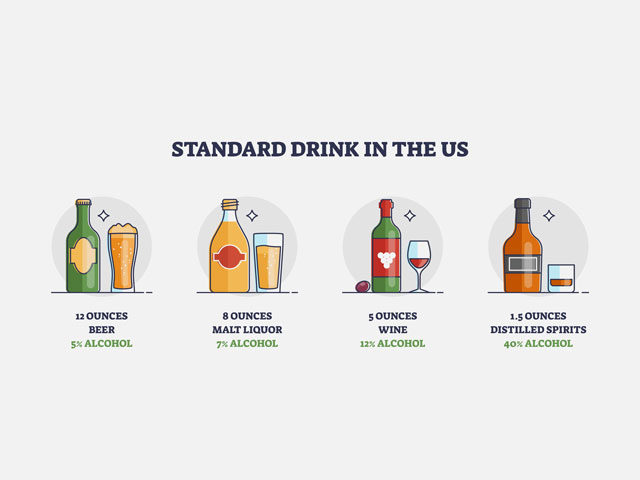A Complete Guide to Beer Alcohol Percentage (ABV)

Key points
- 12 ounces of regular beer, at about 5% ABV.
Whether you're enjoying a crisp lager on a sunny day or a rich stout by the fire, you've likely noticed the "ABV" percentage on the label. This small number holds significant information, influencing everything from the beer's flavor and body to its effect on you. The alcohol content in beer spans a massive range, from virtually zero in non-alcoholic options to percentages that rival hard liquors.
In the United States, a "standard" beer typically has an alcohol by volume (ABV) between 4% and 6%. However, with the explosion of craft brewing and global styles, this is just a small part of the story. This guide will demystify beer alcohol percentages, exploring how they vary by style and what factors influence that final number.
What is ABV and How is It Determined?
ABV stands for Alcohol by Volume, which is the standard measurement of how much alcohol is contained in a given volume of an alcoholic beverage. A beer with 5% ABV means that in a 100 ml serving, 5 ml is pure alcohol.
The alcohol in beer is a natural byproduct of a process called fermentation. Here’s a simplified breakdown:
- Brewers create a sugary liquid called "wort" by steeping malted grains (like barley) in hot water.
- Yeast is added to the wort.
- The yeast consumes the sugars, converting them into two main byproducts: alcohol and carbon dioxide (which gives beer its fizz).
The amount of fermentable sugar in the initial wort is the primary factor determining the final ABV. More sugar gives the yeast more to convert, resulting in a higher alcohol content. Brewers can precisely calculate the ABV by measuring the density of the wort before and after fermentation.
What is a "Standard Drink"?
For responsible consumption, it's essential to understand what constitutes a "standard drink." According to the National Institute on Alcohol Abuse and Alcoholism (NIAAA), one standard drink in the U.S. contains about 14 grams (0.6 ounces) of pure alcohol. For beer, this is equivalent to:
- 12 ounces of regular beer, at about 5% ABV.
A high-ABV craft beer, like a 12-ounce Imperial Stout at 10% ABV, is equivalent to two standard drinks. Being mindful of ABV is key to drinking in moderation.

A Guide to Beer Alcohol Content by Style
The alcohol percentage is a defining characteristic of a beer's style. Here’s a look at the typical ABV ranges for popular categories, from the lightest options to the most potent brews.
Non-Alcoholic and Low-Alcohol Beers (Below 4%)
Driven by the "sober-curious" movement and a general trend towards moderation, the low-to-no alcohol segment is booming.
- Non-Alcoholic (NA) Beer: Legally must contain less than 0.5% ABV.
- Low-Alcohol / "Session" Beers: These are flavorful beers, typically below 5% ABV, designed to be enjoyed over a longer period without causing excessive intoxication. Many fall in the 2.5% to 4% range.
Examples:
- Beck's Light: 2.3% ABV
- Miller 64: 2.8% ABV
- Bell's Light Hearted Ale: 3.7% ABV
Light Lagers and Standard Beers (4% - 5%)
This is the most common and widely consumed category, dominated by major domestic and international brands. These beers are known for being crisp, clean, and refreshing.
Examples of Popular Brands:
- Busch Light: 4.1% ABV
- Bud Light, Coors Light, Miller Lite, Michelob Ultra: 4.2% ABV
- Modelo Especial: 4.4% ABV
- Corona Extra: 4.6% ABV
- Budweiser & Heineken: 5.0% ABV
- Stella Artois: 5.2% ABV
Craft Ales, IPAs, and Stronger Lagers (5% - 7%)
This range is the heartland of the American craft beer movement. Here you'll find beers with more pronounced flavors, from the hoppy bitterness of an IPA to the roasted notes of a porter.
- American Pale Ale: 4.4% - 5.4% ABV
- American India Pale Ale (IPA): 6.3% - 7.5% ABV
- Porters & Stouts: 4.4% - 8.0% ABV
- German-Style Maerzen/Oktoberfest: 5.1% - 6.0% ABV
Examples:
- Sierra Nevada Pale Ale: 5.6% ABV
- New Belgium Fat Tire: 5.2% ABV
- Dogfish Head 60 Minute IPA: 6.0% ABV
- Lagunitas IPA: 6.2% ABV

High-Gravity and Imperial Styles (7% - 12%)
"High-gravity" refers to beers brewed with a higher concentration of sugars, leading to a higher potential ABV. These are bold, complex, and flavorful beers best suited for sipping.
- Double / Imperial IPA: 7.6% - 10.6% ABV
- Russian Imperial Stout: 7% - 12% ABV
- Barleywine: 8.5% - 12.2% ABV
- Belgian Tripel: 7.1% - 10.1% ABV
Examples:
- Russian River Pliny the Elder (Double IPA): 8.0% ABV
- Dogfish Head 90 Minute IPA: 9.0% ABV
- Sierra Nevada Bigfoot (Barleywine): 9.6% ABV
- Brooklyn Black Chocolate Stout: 10.0% ABV
The Extreme End: The World's Strongest Beers (12%+)
Pushing the limits of fermentation, some brewers create exceptionally strong beers that defy convention. To achieve these high percentages, brewers use special, alcohol-tolerant yeast strains and sometimes employ techniques like freeze distillation. This process, used for Eisbocks, involves freezing the beer and removing the ice to concentrate the alcohol.
One of the most famous examples is Scotland's Brewmeister Snake Venom, which claims an astonishing 67.5% ABV, blurring the line between beer and spirits.
Beyond the Brew: What Else Affects Beer ABV?
While the brewing process is central, other external factors can influence the alcohol content of the beer available to you.
Legal and Tax Regulations
In the United States, alcohol regulations can vary significantly by state. Some states have historically imposed caps on the maximum ABV for beer sold in grocery stores or at all. While many states have "popped the cap" to welcome the craft beer boom, a few still have restrictions.
Tax structures can also play a role. As seen in the United Kingdom, which switched to a tax system based on ABV, brewers were incentivized to lower the alcohol content of their beers to reduce their tax burden—a phenomenon dubbed "drinkflation."
Global Variations in Beer Strength
The perception of a "normal" beer strength varies globally.
- United States & United Kingdom: A typical beer is around 4-6% ABV.
- Germany: While many lagers are between 4.7% and 5.4%, stronger styles like Bock or Doppelbock can easily reach 7-16% ABV.
- China: Beers tend to be much lighter, often around 3% ABV.
The Link Between ABV and Flavor
Alcohol is not just an intoxicant; it is a critical flavor component. It contributes to a beer's mouthfeel, body, and perceived warmth. This is why non-alcoholic beers can sometimes taste "thin" or "watery" to those accustomed to their alcoholic counterparts. Higher ABV often correlates with a richer, fuller body and more complex flavors that can evolve as the beer warms.
Understanding Alcohol Content for Responsible Drinking
As public perception shifts and more people become mindful of alcohol's health effects, understanding ABV is more important than ever. A recent Gallup poll found that a majority of Americans now believe moderate drinking is bad for one's health, marking a significant change in attitude.
To put beer's strength in context, here's how it compares to other alcoholic beverages:
- Beer: 4% - 8% (with many craft options much higher)
- Wine: 12% - 16% on average
- Liquor (Spirits): Typically 40% (80 proof) or higher
Always check the label to know the ABV of what you're drinking. A single pint of a 9% Imperial IPA can have the same amount of alcohol as three light beers. Drinking responsibly means knowing your numbers and enjoying the vast world of beer in moderation.
Frequently Asked Questions
What is a typical alcohol percentage for beer? The alcohol percentage in beer, or Alcohol by Volume (ABV), can vary widely. However, a standard or regular beer in the United States typically contains between 4% and 6% ABV. Light beers are often around 4.2% ABV, while many popular lagers and ales are around 5% ABV.
Is 5% alcohol a lot for a beer? A 5% ABV beer is considered moderate in strength. It's stronger than most light beers (which are often around 4.2%) but is a standard strength for many popular brands like Budweiser and Heineken. It's significantly less strong than high-ABV options like double IPAs or imperial stouts, which can range from 8% to 12% or more.
How is the alcohol percentage in beer determined? The alcohol percentage in beer is determined during the fermentation process. Brewers measure the density of the sugary liquid (wort) before fermentation, known as the Original Gravity (OG). After yeast consumes the sugars and creates alcohol, they measure the density again, called the Final Gravity (FG). The difference between the OG and FG allows them to calculate the exact amount of alcohol produced, expressed as ABV.
What is the strongest beer in the world? The title of the world's strongest beer is often contested, but one of the most frequently cited is Brewmeister's "Snake Venom," which has a staggering 67.5% ABV. This is achieved through a combination of brewing and freeze distillation, concentrating the alcohol content to a level similar to hard liquor.
References:
- MedicalNewsToday - How much alcohol is in beer? Units and more
- Homebrew Academy - Beer Alcohol Content ABV% of Popular & Craft Beer Brands
- Adcare.com - The Alcohol Percentage Contents by Beverage Type
- Alcohol.org - Alcohol by Volume (ABV): Beer, Wine, & Liquor
- Firestone Walker Brewing Company - What Does ABV Really Mean?
- Gallup News - U.S. Drinking Rate at New Low as Alcohol Concerns Surge

About the author
Ben Carter, PharmD, is a board-certified clinical pharmacist specializing in infectious diseases. He heads the antibiotic stewardship program at a large teaching hospital in Boston and is an assistant professor at a college of pharmacy.